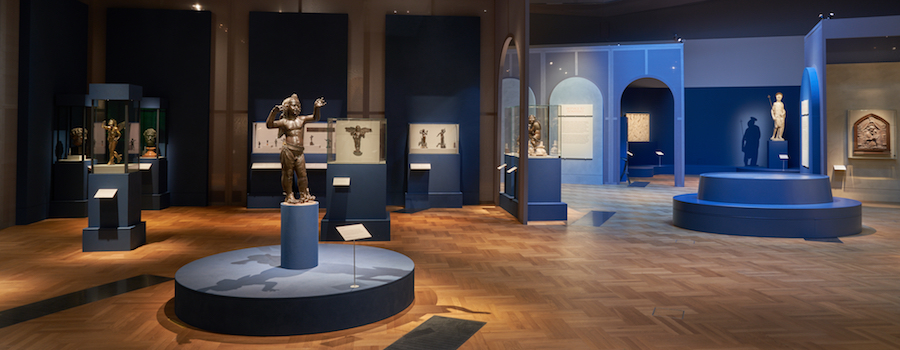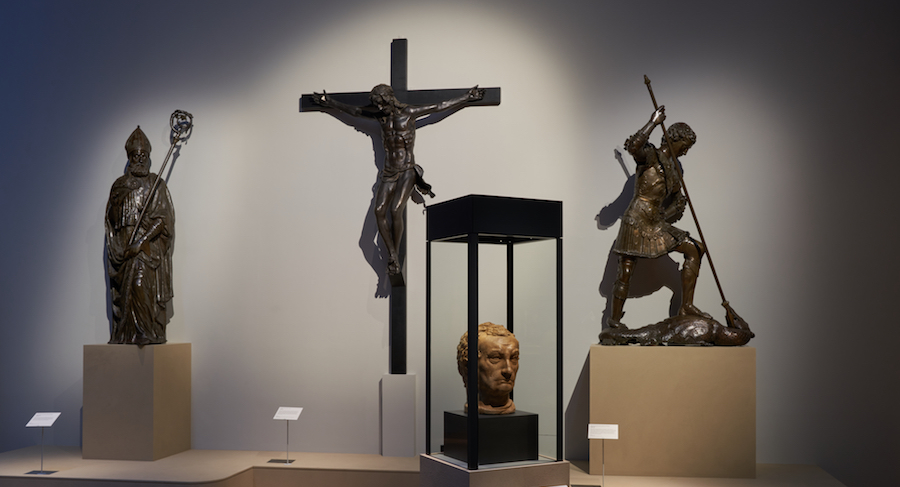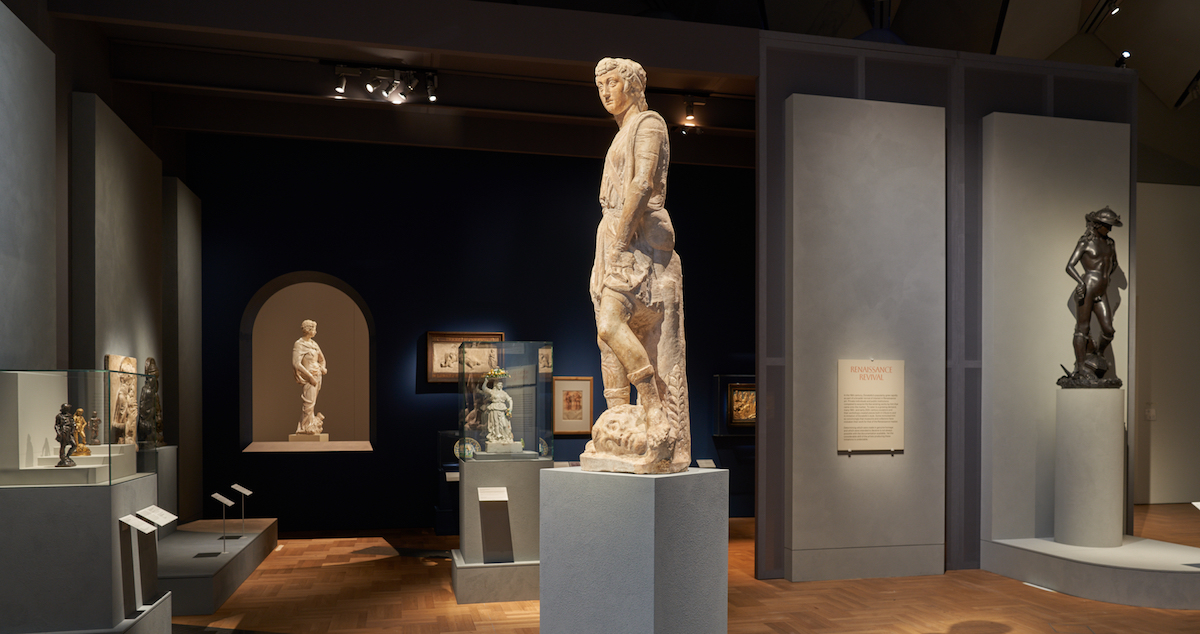About one-third of the way into Donatello: Sculpting the Renaissance we encounter a ‘Virgin and Child’ tondo by Giovanni Pisano, a startlingly naturalistic image in which the Virgin emerges out from the frame of the tondo towards us while the infant Christ also directs his blessing in the same direction. The work of Pisano, who Henry Moore called “the first modern sculptor”, was undoubtedly studied by 15th century artists like Donatello and was a likely source of early inspiration.
Donatello holds a major place within the development of Renaissance art and its context
As well as predecessors – not least Lorenzo Ghiberti in whose workshop he trained – Donatello also worked with significant partners and peers including Filippo Brunelleschi and Michelozzo di Bartolomeo. In his Lives of the Most Excellent Painters, Sculptors, and Architects, Giorgio Vasari recounts a story of Brunelleschi criticising Donatello’s polychrome wooden crucifix for the church of Santa Croce in Florence. Brunelleschi argued that Donatello, through the unrefined proportions and heavy musculature of the crucifix, had put a peasant on the cross. Donatello challenged him to do better and, later, on seeing Brunelleschi’s crucifix (now in the Gondi Chapel at the church of Santa Maria Novella, also in Florence) dropped the provisions bought for their meal as he gazed in wonder at Brunelleschi’s creation.
Vasari’s story contrasts the rough expressive naturalism of some of Donatello’s work with the beauty of proportions in Brunelleschi’s. We can now see that the greatness of Donatello’s work is found in its realism, whether showing tenderness or violence, as the curators of this show frequently flag when they note that those who copied or even corrected Donatello’s work sometimes sweetened it in the process.

This is an exemplary exhibition; one that is both beautifully designed and excellently curated. The exhibition flows, spatially and thematically, through open plan gallery spaces with specific spaces for exploration marked by arches that also open up vistas on to what is yet to come. The exhibition itself provides a broad sweep of Donatello’s career, legacy and works set in the context of influences, partners, colleagues and those influenced by him.
While not initiating renaissance humanism, Donatello considerably extended its scope with his excellence across a range of media, including some, such as rilievo schiacciato, that he invented. The naturalism of his work means he was a major player in the move from divinity encountered through symbolised humanity to realism in depiction whether of divine or secularised humanity. Essentially, renaissance art came to portray the human body as a thing of beauty in its own right and, thereby, began to place human beings, not God or faith, as the centre of attention in life. This move to realism went hand-in-hand with the expansion of scientific discovery which led to the Enlightenment and a societal divide in the West between sacred and secular that continues to drive the forces of secularism. Here, however, it is still found hand-in-glove with the Church and its incarnational belief in the divine fused with the human.
This journey begins with Donatello’s Florentine Foundations including his first sculptures in marble for the Opera del Duomo, such as the exceptional ‘David’ that greets us on arrival, and, as example of the kind of goldsmith’s work with which he would have been involved, a huge gilded head of ‘God the Father’ by his contemporary, Beltramino de Zuttis. Having progressed from the experience of working in wax, clay and bronze gained in Ghiberti’s workshop and working in relationship with painters such as Masaccio, we see examples of Donatello’s partnership with Michelozzo ranging from their declarations for tax assessment to a bronze capital showing dancing spiritelli from the exterior pulpit of Prato Cathedral.

In the next section, Tradition and Innovation, we see examples of Donatello’s innovations in regard to the portrait bust, low relief carvings and Virgin and Child reliefs. We are given context through the inclusion of precedents from which he took inspiration and works by those who followed him. His extraordinary innovation is seen primarily in the expressiveness of his naturalistic figures he creates. Earlier reliquary busts gave idealised images of the saint but his ‘Reliquary bust of San Rossore’ is hyper real and individual. The power of his ‘Pazzi Madonna’ is found in the realism of the loving gesture of interconnection between mother and child seen as their faces are pressed together in profile. This is no posed portrait, instead Donatello gives us a real image of a real mother and child. His skill in shallow relief carving and his use of perspective in his iconic ‘Ascension’ relief is coupled with his ability to capture the atmosphere of the sacred dramas he had experienced on the streets of the city.
The section showing Bronzes: Sacred and Secular demonstrating how Donatello responded to the needs of patrons and different contexts – public and private, sacred and secular – by embracing political and religious messages, both in iconography and choice of material. Much work was undertaken for the powerful Medici family or their circle of influence, including two animated fountain figures and the joyous figure of ‘Attis-Amorino’.
Padua and Northern Italy explores Donatello’s ten-year sojourn in Padua and how this was significant to artistic developments in the surrounding area through his relationships with and impact on sculptors, such as Giovanni da Pisa, and painters, including Mantegna, Bellini, Schiavone, and Zoppo. Here, he created sculptures for the High Altar of the Basilica of St Anthony, including the ‘Miracle of the Mule’, which reveal both his understanding of religious context and his remarkable creative skills in creating space and colouristic effects, while collaborating with talented assistants and the founder Andrea Conti.
In Devotion and Emotion, we have a focus on Donatello’s ability to portray emotion to inspire religious devotional practice. His ‘Lamentation’ relief uses a contrast between the polished and soft flesh of Christ and the unfinished surfaces showing the weeping women around him. The final exhibition section, Homage to Donatello, highlights his legacy; reviewing how his sculpture inspired generations in the later Renaissance, as well as in the nineteenth and early twentieth centuries, in which Renaissance sculpture was both emulated and imitated.
Donatello: Sculpting the Renaissance offers a fresh vision of his impact on the cultural and artistic development of the Renaissance through major commissions of church and state, as an intimate of the Medici family and their circle in Florence, and by being highly sought after in other Italian centres. The focus found here on carefully selected works by Donatello’s contemporaries and followers, as well as key works by Donatello himself, enables a fascinating and informative exploration of this sculptor’s major place within the development of Renaissance art and its context. Here, he can be seen as having been in the vanguard of a revolution in sculptural practice in the early Renaissance and, also, as one of greatest sculptors of all time.
Donatello: Sculpting the Renaissance, V&A, 11 February – 11 June 2023

